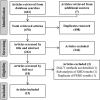A scoping review of burden of disease studies estimating disability-adjusted life years due to Taenia solium
- PMID: 35793356
- PMCID: PMC9292123
- DOI: 10.1371/journal.pntd.0010567
A scoping review of burden of disease studies estimating disability-adjusted life years due to Taenia solium
Abstract
Background: Taenia solium is the most significant global foodborne parasite and the leading cause of preventable human epilepsy in low and middle-income countries in the form of neurocysticercosis.
Objectives: This scoping review aimed to examine the methodology of peer-reviewed studies that estimate the burden of T. solium using disability-adjusted life years.
Eligibility criteria: Studies must have calculated disability-adjusted life years relating to T. solium.
Charting methods: The review process was managed by a single reviewer using Rayyan. Published data relating to disease models, data sources, disability-adjusted life years, sensitivity, uncertainty, missing data, and key limitations were collected.
Results: 15 studies were included for review, with seven global and eight national or sub-national estimates. Studies primarily employed attributional disease models that relied on measuring the occurrence of epilepsy before applying an attributable fraction to estimate the occurrence of neurocysticercosis-associated epilepsy. This method relies heavily on the extrapolation of observational studies across populations and time periods; however, it is currently required due to the difficulties in diagnosing neurocysticercosis. Studies discussed that a lack of data was a key limitation and their results likely underestimate the true burden of T. solium. Methods to calculate disability-adjusted life years varied across studies with differences in approaches to time discounting, age weighting, years of life lost, and years of life lived with disability. Such differences limit the ability to compare estimates between studies.
Conclusions: This review illustrates the complexities associated with T. solium burden of disease studies and highlights the potential need for a burden of disease reporting framework. The burden of T. solium is likely underestimated due to the challenges in diagnosing neurocysticercosis and a lack of available data. Advancement in diagnostics, further observational studies, and new approaches to parameterising disease models are required if estimates are to improve.
Conflict of interest statement
The authors have declared that no competing interests exist.
References
-
- FAO, WHO. Multicriteria-based ranking for risk management of food-borne parasites. Rome: FAO; 2014.
-
- Torgerson PR, Devleesschauwer B, Praet N, Speybroeck N, Willingham AL, Kasuga F, et al.. World Health Organization Estimates of the Global and Regional Disease Burden of 11 Foodborne Parasitic Diseases, 2010: A Data Synthesis. PLoS Medicine. 2015;12:1–22. doi: 10.1371/journal.pmed.1001920 - DOI - PMC - PubMed
-
- WHO. Preventable epilepsy: taenia solium infection burdens economies, societies and individuals: a rationale for investment and action. Geneva: 2016.


